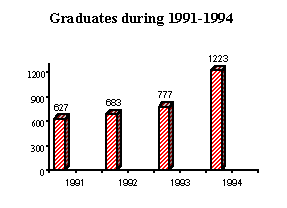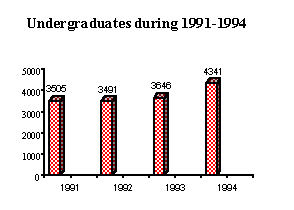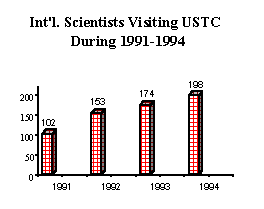

The University of Science and Technology of China (USTC) is a national key university with comprehensive faculties of science, technology and arts. Affiliated with the Chinese Academy of Sciences (CAS), the university was founded in Beijing in September 1958 under the presidential leadership of Dr. Guo Moruo, then President of the CAS. From the beginning, USTC has prospered from a strong relationship with the CAS that is based on the Academy's policy of the entire academy committing to the university, whereby all institutes under the CAS are to maintain active cooperation with the university's corresponding faculties. Since 1970, when USTC moved to Hefei, the capital of Anhui Province, the university has flourished from the development of rich cooperation with surrounding institutions and industry. In accordance with the national open-door policy enacted in 1978, USTC has launched a series of reforms, achieving recognition by the State Council during the 7th and 8th Five-year Plan periods as one of the State key institutions of higher education. USTC pioneered in its efforts to recreate education following the Cultural Revolution, establishing its current leadership role in preparing China's citizens for the 21st Century. Deng Xiaoping, then the Secretary General of the Chinese Communist Party, lauded the university during a visit in 1983: "USTC has been doing very well. They have a lot of talented young personnel." The University has made considerable progress in every aspect, continually improving its facilities and environment for educational training and scientific research. The universityís principle of "Studying diligently, unifying theory with practice, placing equal importance on integrity and ability" is deep in the minds of all staff and students.
At present, USTC is headed by a number of renowned professors in the fields of science and technology. Professor Yan Jici, a famous physicist, is the university's Honorary President. Professor Tang Honggao, physicist and alternate member of the Central Committee of the Chinese Communist Party, is the President. Vice-president and USTC Communist Party Secretary is Professor Yu Xianglin, an expert in microwave technology. The USTC President's Consultant Committee headed by Dr. Zhou Guangzhao, President of the CAS, was established in 1993 to further facilitate administration of the University's expanding system. This system contains 22 departments and a special class for the Gifted Young, two graduate schools located in Beijing and Hefei, a School of Science, a School of Business, a Management School, a Hi-Tech School, and an Adult Education Center. Bachelor, Master and Doctoral candidates may pursue their studies in any of the 50 specialties conferring Bachelor degrees, 47 offering Masterís degrees and 54 awarding Doctoral degrees. Seventeen specialties in seven fields have the authority of providing Post-doctoral studies. Among the National key fields of study at the University are Pure Mathematics, Computational Mathematics, Condensed Matter Physics and Solid State Mechanics. The USTC Departments of Mathematics, Physics and Mechanics have been selected by the State Education Commission as training bases for research personnel. Two national key laboratories, the National Synchrotron Radiation Laboratory and the State Key Laboratory of Fire Science, are located at the University, and the CAS Structure and Element Analysis Center, Cognitive Science Laboratory, and Laboratory of Internal Friction and Defects in Solids have been named as open-lab supervised by scientists from all over the country providing services to scientists nationwide.
At present, the university staff numbers 3450, including a total teaching staff of 1650. Of these, 274 are professors, and 592 associate professors. The university's excellence in education stems from the wealth of initiative, diligence and vitality possessed by the faculty.
The number of students enrolled in university programs currently totals 6080, including 159 Ph.D students, 807 Masterís students, 3855 undergraduates, and 1259 training students. Additionally, there are 2740 students on campus participating in various adult education programs. USTC has consistently maintained a freshman class with the highest average entrance exam scores in China since 1977.


Three campuses in Hefei cover a total area of 113 hectares (1692 mu), with a total construction area of 370,000 square meters. USTC is fully furnished with advanced equipment and instruments for teaching and research. The book collection in the main library exceeds one million.
USTC commits itself to fostering the growth of science and technology by adhering to a pedagogical philosophy which integrates teaching with research and theory with practice. The university places great emphasis on training students with the basic theoretical knowledge, intellectual skills and scientific research capabilities practical for future leadership roles in the country's development. USTC graduates are strong in analytical and computer applications, and proficient in a number of world languages. For example, the total average scores of USTC students on the national College English Test 4 (CET 4) and College English Test 6 ( CET 6) tests among Chinese non-English major students have successively been the highest for years. They are eager to learn and quick to grasp and remain abreast of the latest technology. In over thirty years, USTC has trained more than 24,000 outstanding graduates. They have been serving the nation in fundamental research and teaching capacities and in the application and development of new and high technology. Many of them have become the backbone of their specialties and fields. Some have been important leaders, making great contributions to the nation. In recent years, besides meeting the needs of CAS, USTC graduates have been recruited by a variety of renowned organizations and corporations throughout China.
In addition to excellent teaching, the university supports a thriving scientific research and development environment. As an important scientific research center, it exhibits significant influence both in China and in the world. Since 1978, USTC has achieved 677 outstanding results in scientific research. Among them, more than 200 were at the international level, 36 were national awards, and 355 were CAS, provincial and ministry level awards. USTC is ranked among the first four Chinese institutions of higher education based on the number of papers quoted by international abstract journals. The National Synchrotron Radiation Laboratory (NSRL), the only dedicated synchrotron facility in China, is the first large-scale scientific research project supported by the Central Government built in a university. The NSRL receives special recognition from the CAS, and has been regarded as a significant achievement in the field of high technology in China. The State Key Laboratory of Fire Sciences is the first key laboratory in China for research centered on fire mechanisms. USTC's superconductor research is esteemed among the international community. While leading in fundamental research, USTC vigorously pursues the research and development of hi-technology. In trying to meet the demands of the country's economic development, USTC has successfully established and expanded its scientific and technological collaborations with industries, such as the Daqin Oil Company, Petrochemical Company, Baoshan Steel Company, and Ma'anshan Steel Company, Hefei-Sanyo Washing Machine Co. Ltd. The Hefei Hi-Tech Plaza is a successful USTC joint venture specially aimed at serving the needs of organizations producing and engaging in hi-tech products.
USTC strives to promote international academic exchanges and scientific research cooperation. Since 1978, more than 30 cooperative and exchange programs have been developed with more than 20 universities and scientific research institutions in 11 countries and regions. Every year, about 200 foreign scholars visit USTC to give lectures or to take part in short-term cooperative research. Many world celebrated scientists, such as Dr. C.N. Yang, Dr. T.D. Lee, Dr. A. Salam, G. Andreotti, Dr. S.C.C. Ting, and Dr. Y. T. Lee, have been awarded Honorary Professors or Honorary Ph.D Holders , more others have been invited to USTC as Honorary and Guest professors. USTC is actively engaged in a great number of international exchanges. The university has progressively sent more than 1500 faculty members to study in over 20 countries and areas. Many of them have returned to take important posts in scientific research and administration.

Since its founding, USTC has continued to explore effective methods for enhancing education. It has pioneered the establishment of special classes for the gifted young of China, the distinction of major disciplines from ancillary ones, the use of the credit system, and the institution of the 4-year, 2-year and 3- year accelerated education program for students receiving Bachelor, Master and Doctorate degrees. The spirit of national reform and open policy along with the rapid pace of economic development has brought about new opportunities for the university. Drawing on the collective wisdom of the entire faculty, USTC is proceeding with its goal to deepen its education reform, now in its third phase of development. Targeting the "State's 211 Project", USTC continues to respect the Party's basic line and strives to provide a modern education system geared to meeting the needs of global scientific development and China's market economy. With an eye on specialty development and talent training, the university will continue to develop its teaching, scientific research and social service capacities. USTC tries its best to sustain its leadership at home and prestige world-wide, according to its mission: "To Build a Global University and Educate the Brilliant of the World."


